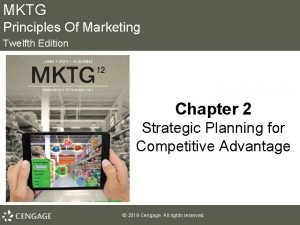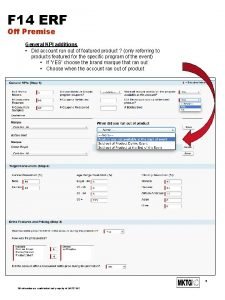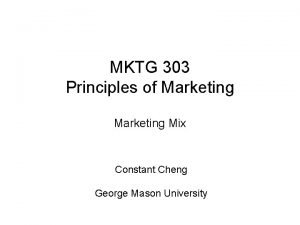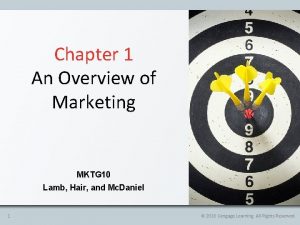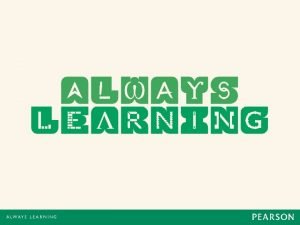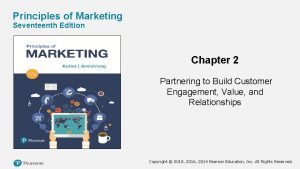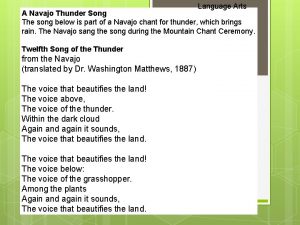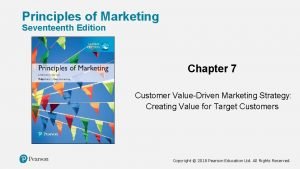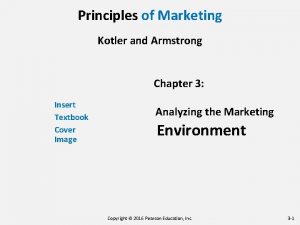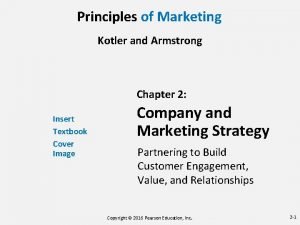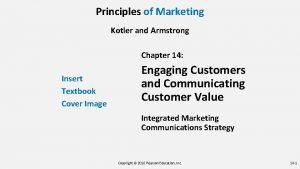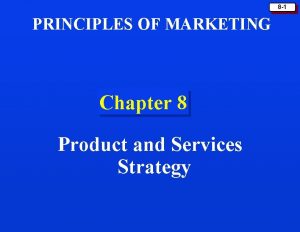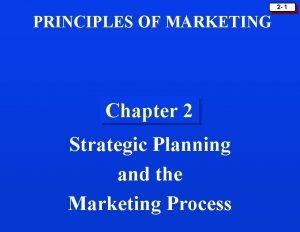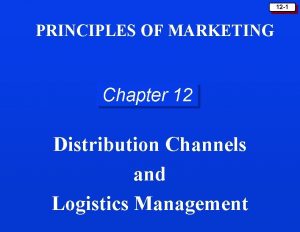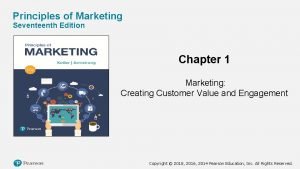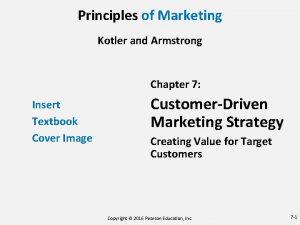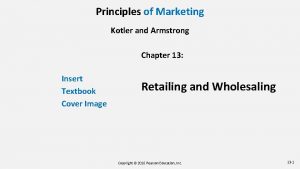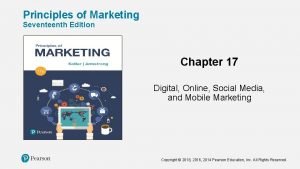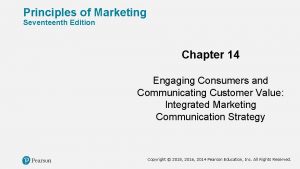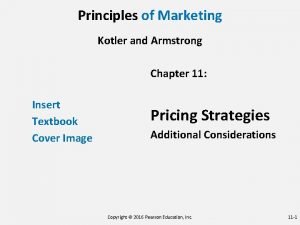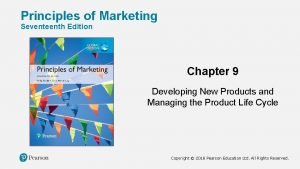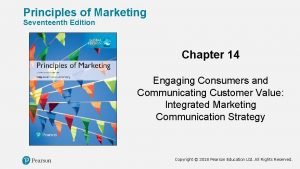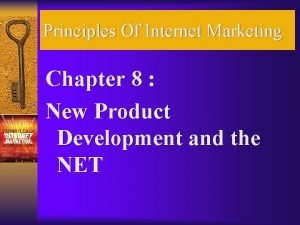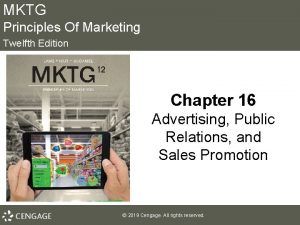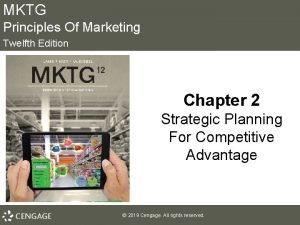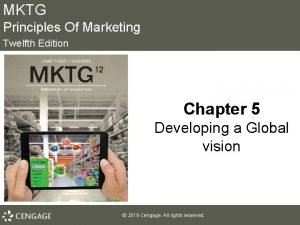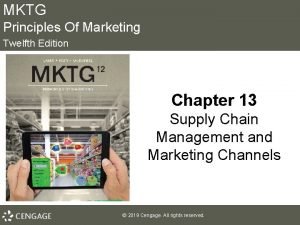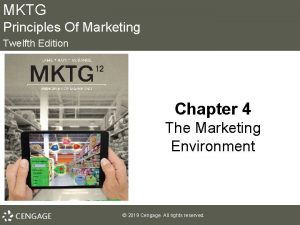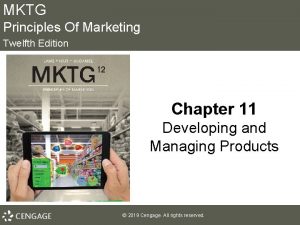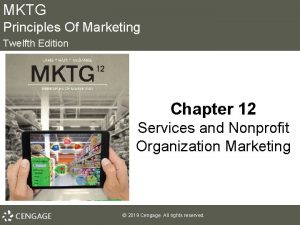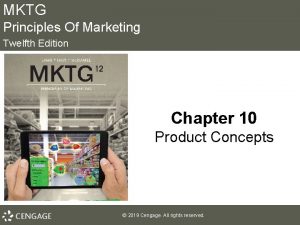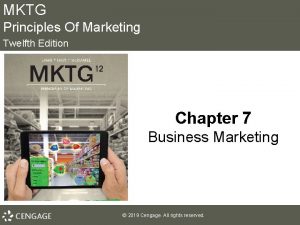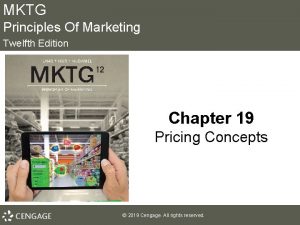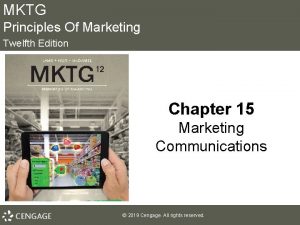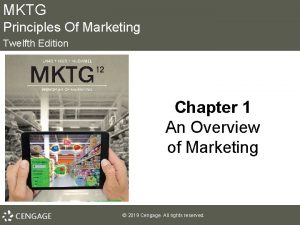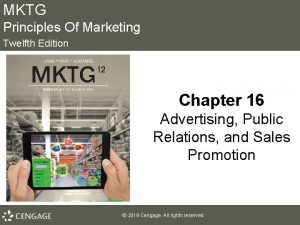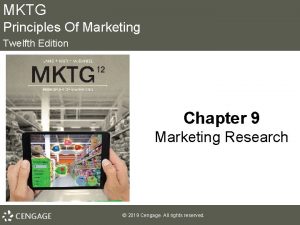MKTG Principles Of Marketing Twelfth Edition Chapter 9

















































- Slides: 49

MKTG Principles Of Marketing Twelfth Edition Chapter 9 Marketing Research © 2019 Cengage. All rights reserved.

Learning Outcomes (slide 1 of 2) 9 -1 9 -2 9 -3 9 -4 Define marketing research and explain its importance to marketing decision making Describe the steps involved in conducting a marketing research project Discuss the profound impact of the Internet on marketing research Describe the growing importance of mobile research © 2019 Cengage. All rights reserved.

Learning Outcomes (slide 2 of 2) 9 -5 9 -6 9 -7 Discuss the growing importance of scannerbased research Explain when marketing research should be conducted Explain the concept of competitive intelligence © 2019 Cengage. All rights reserved.

Marketing Research (slide 1 of 2) • Marketing research: the process of planning, collecting, and analyzing data relevant to a marketing decision – Links the consumer, customer, and public to the marketer through information – Provides data on the effectiveness of a marketing mix and insights for necessary changes – It is the main data source for management information systems © 2019 Cengage. All rights reserved.

Marketing Research (slide 2 of 2) • Marketing research has three roles: – Descriptive – Diagnostic – Predictive © 2019 Cengage. All rights reserved.

Management Uses of Marketing Research • • Improves the quality of decision making Helps managers trace problems Helps managers understand detailed and complicated relationships Helps managers serve customers accurately and efficiently © 2019 Cengage. All rights reserved.

Understanding the Ever-Changing Marketplace • Marketing research helps managers understand what is going on in the marketplace and take advantage of opportunities • One of the hottest trends in technology today is the Internet of Things (Io. T) – By 2019, 69 percent of consumers plan to have at least one Io. T device, such as a thermostat or security system – Younger consumers are most likely to adopt connected technologies later on, while older consumers are slightly more likely to already own certain products © 2019 Cengage. All rights reserved.

Steps in a Marketing Research Project • Marketing research problem: determining what information is needed and how it can be obtained efficiently and effectively • Marketing research objective: the specific information needed to solve a marketing research problem; the objective should be to provide insightful decision-making information • Management decision problem: a broad-based problem that uses marketing research in order for managers to take proper actions © 2019 Cengage. All rights reserved.

Exhibit 9. 1 The Marketing Research Process © 2019 Cengage. All rights reserved.

Secondary Data (slide 1 of 2) • Secondary data: data previously collected for any purpose other than the one at hand • Secondary information originating within the company includes: – The company’s websites – Annual reports – Reports to stockholders – Blogs – Product testing results – You. Tube videos – Social media posts – House periodicals composed by the company’s personnel for communication to employees, customers, or others © 2019 Cengage. All rights reserved.

Secondary Data (slide 2 of 2) • Sources of secondary data outside of the company include: – – Government agencies Trade and industry associations Business periodicals News media © 2019 Cengage. All rights reserved.

Advantages and Disadvantages of Secondary Data • Advantages – – – Save time and money Aid in formulating the problem statement Suggest research methods and data to solve problems Pinpoint the kinds of people to approach Serve as a basis of comparison for other data • Disadvantages – May not give adequate detailed information – Quality and accuracy of data may pose a problem © 2019 Cengage. All rights reserved.

The Growing Importance of Social Media Data • Facebook owns and controls data collected from 2 billion daily users and 79 billion monthly active users • In an effort to expand its information databases even further, Facebook now combines its social data with third-party information from data brokerages like Acxiom, Datalogix, and Alliance Data Systems • New Facebook tool allows advertisers to calculate their return on investment • Facebook has also begun using the like and share buttons embedded in non-Facebook websites to track peoples’ browsing histories, so it can more accurately and narrowly target ads © 2019 Cengage. All rights reserved.

The Incredible World of Big Data • Big data: the exponential growth in the volume, variety, and velocity of information and the development of complex, new tools to analyze and create meaning from such data • Gathered both online and offline • Data visualization uncovers subtle patterns from billions of pieces of data – Enables managers to share and explain their findings © 2019 Cengage. All rights reserved.

Planning the Research Design and Gathering Primary Data • Research design: specifies which research questions must be answered, how and when to gather data, and how the data will be analyzed • Project budget is finalized after the research design is approved • Primary data: information collected for the first time; used for solving the particular problem under investigation – Answers specific research questions – Data are current, and source of data is known – Secrecy can be maintained © 2019 Cengage. All rights reserved.

Survey Research (slide 1 of 4) • Survey research: the most popular technique for gathering primary data, in which a researcher interacts with people to obtain facts, opinions, and attitudes – In-home personal interviews: Although in-home personal interviews often provide high-quality information, they tend to be very expensive because of the interviewers’ travel time and mileage costs – Mall intercept interviews: a survey research method that involves interviewing people in the common areas of a shopping mall © 2019 Cengage. All rights reserved.

Survey Research (slide 2 of 4) – Computer-assisted personal interviewing: an interviewing method in which the interviewer reads questions to the respondent off a computer screen and enters the respondent’s data directly into the computer – Computer-assisted self-interviewing: an interviewing method in which a mall interviewer intercepts and directs willing respondents to nearby computers where each respondent reads questions off a computer screen and directly keys his or her answers into the computer © 2019 Cengage. All rights reserved.

Survey Research (slide 3 of 4) – Telephone interviews: Telephone interviews cost less than personal interviews, but cost is rapidly increasing due to respondent refusals to participate § Central-location telephone (CLT) facility: a specially designed phone room used to conduct telephone interviewing – Mail surveys: Mail surveys have several benefits: relatively low cost, elimination of interviewers and field supervisors, centralized control, and actual or promised anonymity for respondents § Mail panels offer an alternative to the one-shot mail survey © 2019 Cengage. All rights reserved.

Survey Research (slide 4 of 4) – Executive interview: a type of survey that usually involves interviewing business people at their offices concerning industrial products or services – Focus group: seven to ten people who participate in a group discussion led by a moderator © 2019 Cengage. All rights reserved.

Exhibit 9. 2 Characteristics of Traditional Forms of Survey Research © 2019 Cengage. All rights reserved.

Questionnaire Design • Questionnaires ensure that all respondents will be asked the same series of questions • Open-ended question: an interview question that encourages an answer phrased in the respondent’s own words • Closed-ended question: an interview question that asks the respondent to make a selection from a limited list of responses • Scaled-response questions: a closed-ended question designed to measure the intensity of a respondent’s answer © 2019 Cengage. All rights reserved.

Exhibit 9. 3 Types Of Questions Found on Questionnaires for National Market Research © 2019 Cengage. All rights reserved.

Observation Research (slide 1 of 2) • Observation research: a research method that relies on four types of observation: people watching people, people watching an activity, machines watching people, and machines watching an activity – A market researcher using the observation technique witnesses and records information as events occur or compiles evidence from records of past events – Mystery shoppers: researchers posing as customers who gather observational data about a store © 2019 Cengage. All rights reserved.

Observation Research (slide 2 of 2) – Behavioral targeting (BT): a form of observation marketing research that combines a consumer’s online activity with psychographic and demographic profiles compiled in databases § Social media monitoring: the use of automated tools to monitor online buzz, chatter, and conversations – Ethnographic research: the study of human behavior in its natural context; involves observation of behavior and physical setting – Virtual shopping: simulation of an actual retail store environment on a computer screen – Experiment: a method of gathering primary data in which the researcher alters one or more variables while observing the effects of those alterations on another variable © 2019 Cengage. All rights reserved.

Exhibit 9. 4 Observational Situations Situation Example People watching people Observers stationed in supermarkets watch consumers select frozen Mexican dinners; the purpose is to see how much comparison shopping people do at the point of purchase. People watching an activity An observer stationed at an intersection counts traffic moving in various directions. Machines watching People Movie or videotape cameras record behavior as in the people watching people example above. Machines watching an activity Traffic-counting machines monitor traffic flow. © 2019 Cengage. All rights reserved.

Specifying the Sampling Procedures • Sample: a subset from a larger population • Universe: the population from which a sample will be drawn • Probability sample: a sample in which every element in the population has a known statistical likelihood of being selected – Random sample: a sample arranged in such a way that every element of the population has an equal chance of being selected as part of the sample • Nonprobability sample: any sample in which little or no attempt is made to get a representative cross section of the population – Convenience sample: a form of nonprobability sample using respondents who are convenient or readily accessible to the researcher—for example, employees, friends, or relatives © 2019 Cengage. All rights reserved.

Exhibit 9. 5 Types of Samples © 2019 Cengage. All rights reserved.

Types of Errors • Measurement error: an error that occurs when there is a difference between the information desired by the researcher and the information provided by the measurement process • Sampling error: an error that occurs when a sample does not represent the target population – Nonresponse error: occurs when the sample actually interviewed differs from the sample drawn – Frame error: an error that occurs when a sample drawn from a population differs from the target population – Random error: an error that occurs when the selected sample is an imperfect representation of the overall population © 2019 Cengage. All rights reserved.

Collecting the Data • Field service firms: a firm that specializes in interviewing respondents on a subcontracted basis – A typical marketing research study involves data collection in several cities, which may require the marketer to work with a comparable number of field service firms – Provide focus group facilities, mall intercept locations, test product stores, and kitchen facilities to prepare test food products © 2019 Cengage. All rights reserved.

Analyzing the Data • Analysis helps to interpret and draw conclusions from the mass of collected data • Data are organized using techniques such as one-way frequency counts, cross-tabulations, and sophisticated statistical analysis – One-way frequency tables record the responses to a question and provide a general picture of the study’s results. – Cross-tabulation: a method of analyzing data that lets the analyst look at the responses to one question in relation to the responses to one or more other questions © 2019 Cengage. All rights reserved.

Exhibit 9. 6 Popcorn Cross-Tabulation © 2019 Cengage. All rights reserved.

Preparing and Presenting the Report and Follow Up • After data analysis, researchers prepare the report and communicate conclusions and recommendations to management • Contents of a report: – – Concise statement of the research objectives Brief explanation of research design Summary of major findings Conclusion with recommendations • Follow up: – Researcher should determine why management did or did not carry out the recommendations © 2019 Cengage. All rights reserved.

Discussion Point The Marketing Research Process • Read the following examples: – Marketers at Lego observe thousands of children playing with Legos – Gatorade determines they need to “Assess the hydration needs of endurance athletes before, during, and after athletic events. ” – Marketers at Folgers examine recorded responses to the internet survey distributed to coffee drinkers – Researchers at Nintendo look at previous quarterly reports to determine sales trends – Marketers conducting a survey determine that every person in the population has a known statistical likelihood of being selected Determine which step of the marketing research process is described in each of the examples. © 2019 Cengage. All rights reserved.

The Profound Impact of the Internet on Marketing Research • Most American marketing research companies conduct some form of online research • Online survey research has replaced computer-assisted telephone interviewing as the most popular mode of data collection © 2019 Cengage. All rights reserved.

Advantages of Internet Surveys • Advantages of Internet surveys include: – – – Rapid development Reduced costs Personalized questions and data Improved respondent participation Contact with the hard-to-reach © 2019 Cengage. All rights reserved.

Uses of the Internet by Marketing Researchers • Market researches use the Internet to: – Administer surveys – Conduct focus groups – Performa a variety of other types of marketing research © 2019 Cengage. All rights reserved.

Methods of Conducting Online Surveys • Web survey systems – Designed for web questionnaire construction and delivery • Google consumer surveys – Do-it-yourself web surveys • Online panel providers – Pre-recruit people who agree to participate in online surveys © 2019 Cengage. All rights reserved.

Online Focus Groups • Advantages of online focus groups: – – Better participation rates Cost-effectiveness Broad geographic scope Accessibility © 2019 Cengage. All rights reserved.

Online Research Communities • Web communities – Selected group of consumers who agree to participate in an ongoing dialogue with a particular corporation • Benefits – Provide cost-effective, flexible research – Helps companies create customer-focused organizations and achieves customer-derived innovations – Establishes brand advocates – Offers real-time results © 2019 Cengage. All rights reserved.

The Growing Importance of Mobile Research • Mobile surveys account for about half of interview responses • It is designed to fit into brief cracks of time • New and better apps make the survey experience easier and more intuitive © 2019 Cengage. All rights reserved.

Scanner-Based Research • Scanner-based research: a system for gathering information from a single group of respondents by continuously monitoring the advertising, promotion, and pricing they are exposed to and the things they buy • The two major scanner-based suppliers are Symphony. IRI Group Inc. and the Nielsen Company – Info. Scan: a scanner-based sales-tracking service for the consumer packaged-goods industry • Neuromarketing: Studies the body’s responses to marketing stimuli © 2019 Cengage. All rights reserved.

When Should Marketing Research Be Conducted? • Depends on managers’ perceptions of its quality, price, and timing • When the expected value of research information exceeds the cost of generating the information © 2019 Cengage. All rights reserved.

Customer Relationship Management • CRM is described as a closed-looped system that builds relationships with customers – The CRM cycle is initiated by identifying customer relationships within the organization – Next, the company must understand the interaction each customer has with the company by building on the initial information collected and developing a useful database – The company can then acquire and capture all relevant information about the customer – Technology is used to store and integrate customer data – The company must use data mining to determine its profitable and unprofitable customer segments – Leverage customer information © 2019 Cengage. All rights reserved.

Exhibit 9. 7 A Simple Flow Model of the Customer Relationship Management System © 2019 Cengage. All rights reserved.

Competitive Intelligence • Derived from military intelligence, competitive intelligence is an important tool for helping a firm overcome a competitor’s advantage • Competitive intelligence: an intelligence system that helps managers assess their competition and vendors in order to become more efficient and effective competitors – It can help identify the advantage and play a major role in determining how it is achieved – Sources of competitive intelligence include the Internet, company salespeople, industry experts, government agencies, suppliers, and industry trade shows © 2019 Cengage. All rights reserved.

Key Terms (slide 1 of 4) • • • Marketing research problem Marketing research objective Management decision problem Secondary data Big data Research design Primary data Survey research Mall intercept interview © 2019 Cengage. All rights reserved.

Key Terms (slide 2 of 4) • • • Computer-assisted personal interviewing Computer-assisted self interviewing Central-location telephone (CLT) facility Executive interview Focus group Open-ended question Closed-ended question Scaled-response question Observation research Mystery shoppers © 2019 Cengage. All rights reserved.

Key Terms (slide 3 of 4) • • • Behavioral targeting (BT) Social media monitoring Ethnographic research Experiment Sample Universe Probability sample Random sample Nonprobability sample Convenience sample © 2019 Cengage. All rights reserved.

Key Terms (slide 4 of 4) • • • Measurement error Sampling error Frame error Random error Field service firm Cross-tabulation Scanner-based research Info. Scan Neuromarketing Competitive intelligence (CI) © 2019 Cengage. All rights reserved.
 Mktg 12 principles of marketing
Mktg 12 principles of marketing Mktg 12th edition
Mktg 12th edition Principles of marketing chapter 9
Principles of marketing chapter 9 Ricky w griffin management 12th edition pdf
Ricky w griffin management 12th edition pdf Mktg 8
Mktg 8 Mktg erf
Mktg erf Chapter 2 sports and entertainment marketing
Chapter 2 sports and entertainment marketing Mktg 303
Mktg 303 Mktg 10
Mktg 10 Principles of marketing fifth european edition
Principles of marketing fifth european edition Marketing kotler
Marketing kotler Principles of marketing chapter 2
Principles of marketing chapter 2 Principles of marketing quarter 1 module 2
Principles of marketing quarter 1 module 2 Using mis 10th edition
Using mis 10th edition Report
Report Structure of twelfth night
Structure of twelfth night Twelfth night ppt
Twelfth night ppt Cesario come for so you shall be
Cesario come for so you shall be Structure of twelfth night
Structure of twelfth night Dramatic techniques in twelfth night
Dramatic techniques in twelfth night Twelfth night act 1 scene 5 summary
Twelfth night act 1 scene 5 summary I am not what i am twelfth night
I am not what i am twelfth night Themes in twelfth night
Themes in twelfth night Language
Language Twelfth night act 5
Twelfth night act 5 Stock characters in twelfth night
Stock characters in twelfth night Jenny phelps
Jenny phelps Msik
Msik Satire in twelfth night
Satire in twelfth night Deverell twelfth night
Deverell twelfth night I disappeared on the night before my twelfth birthday
I disappeared on the night before my twelfth birthday Ironic and humorous plays
Ironic and humorous plays Principles of marketing chapter 7
Principles of marketing chapter 7 Principle of marketing chapter 5
Principle of marketing chapter 5 Chapter 3 principles of marketing
Chapter 3 principles of marketing Chapter 2 principles of marketing
Chapter 2 principles of marketing Marketing chapter 14
Marketing chapter 14 Product line decisions
Product line decisions Principles of marketing chapter 2
Principles of marketing chapter 2 Marketing chapter 12
Marketing chapter 12 Marketing chapter 3
Marketing chapter 3 Chapter 1 marketing
Chapter 1 marketing Principles of marketing philip kotler ppt
Principles of marketing philip kotler ppt Principles of marketing chapter 13
Principles of marketing chapter 13 Principles of marketing chapter 17
Principles of marketing chapter 17 Principles of marketing chapter 14
Principles of marketing chapter 14 Pricing by philip kotler
Pricing by philip kotler Principles of marketing chapter 9
Principles of marketing chapter 9 Principles of marketing chapter 14
Principles of marketing chapter 14 Principles of internet marketing
Principles of internet marketing
